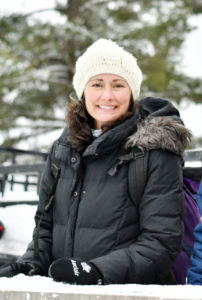
A story of identifying needs and developing opportunities for gap-based silviculture
The Institute awarded Dr Christel C. Kern, Research Forester and Certified Silviculturist, at USDA Forest Service-Northern Research Station, the 2018 Percy Stubbs, John Bolton King and Edward Garfitt Prize for Silviculture. You can read the award winning paper here. Dr Kern tells the Institute how the paper was developed.
Nothing can be more rewarding than advancing both science and practice and working with those who you respect in your field. I was fortunate to have this experience through the development of the paper selected for the 2018 Percy Stubbs and John Bolton King and Edward Garfitt Prize for Silviculture. Here’s my story.
As a graduate student, I was overwhelmed with the number of studies on canopy gaps. In addition, the cross-over between silviculture and ecology research was limited. Regardless, the silvicultural and ecological literature suggested that the size of a canopy gap and regeneration of tree diversity were related: larger openings means more types of trees species can coexist.
In my part of the world, foresters began tinkering with adding ‘gaps’ in the 1990s. The harvest-created gaps were prescribed to accelerate development of new age classes and tree species diversity in our shade–tolerant, second-growth, and largely even-aged forests. Foresters were also trying to hit the ‘sweet spot’ in gap size to target specific species that were mid-tolerant to shade.
My own dissertation project in the 2000s evaluated this idea, too. My predecessor had pictures of masses of mid-tolerant birch regenerating in the intermediate-sized gaps. Twelve years post-harvest, I wasn’t seeing those patches of birch.
At the same time, foresters were revisiting their gap-treated stands for the next cutting cycle and were seeing mixed results. They were asking me for answers. While my field study was well-designed with replication, it was really a case study at that subcontinental level. So the need for synthesis wasn’t just scientific, there was a practical need, too.
I began to scrutinise published literature even more. Through the process, I started to recognise names of researchers working on similar applied research. I knew the best synthesis would not come from me alone but from a rich set of professional knowledge and experience from that subcontinental scale.
In 2012, I organised a session at a professional conference and invited those researchers to participate. As a result, my dream team of applied thinkers came together to present their individual research and then we began to strategise a plan for synthesis.
Our goal was to write a paper that clearly advanced science and practice. We aimed to substantiate the dogma about gap size and tree diversity by reviewing what was established in the literature and what was happening in practice across the mesic forests of North America. Then, we integrated newer studies, including my own and the work of others, questioning the simplicity of using only gap cutting to influence tree diversity.
We highlighted the disparity of what was expected and what resulted. In some cases, seed sources are simply not available to regenerate a diverse cohort of tree species. Or, invasive pests and pathogens limit success of tree regeneration. In other more complicated cases, modern forest conditions continue to change and what we have learned from past applications and studies does not always apply to today’s forest conditions.
In the end, we wanted scientists to carry forward the idea of ‘messy’ gaps or how more complex implementation would influence the diversity of biota and the resilience of forests. For foresters, we wanted to deliver a summary of the lessons learned across the subcontinent and benefit from already-tried ideas. Overall, we hoped a scientist could further develop and a forester could apply our ideas.
Disclaimer: The views and opinions expressed in this article are those of the author and do not necessarily reflect the views of the Institute of Chartered Foresters.





